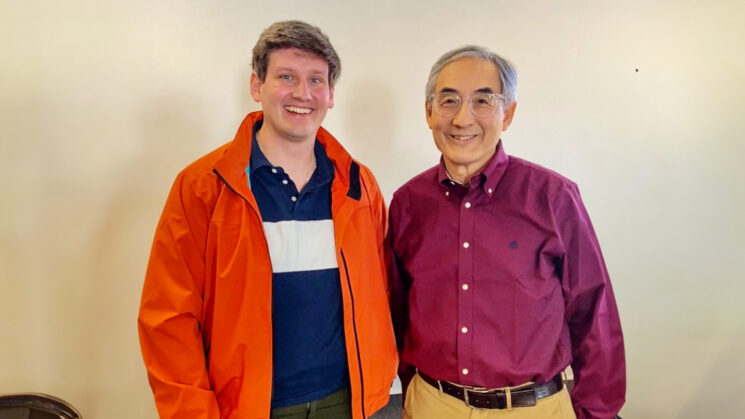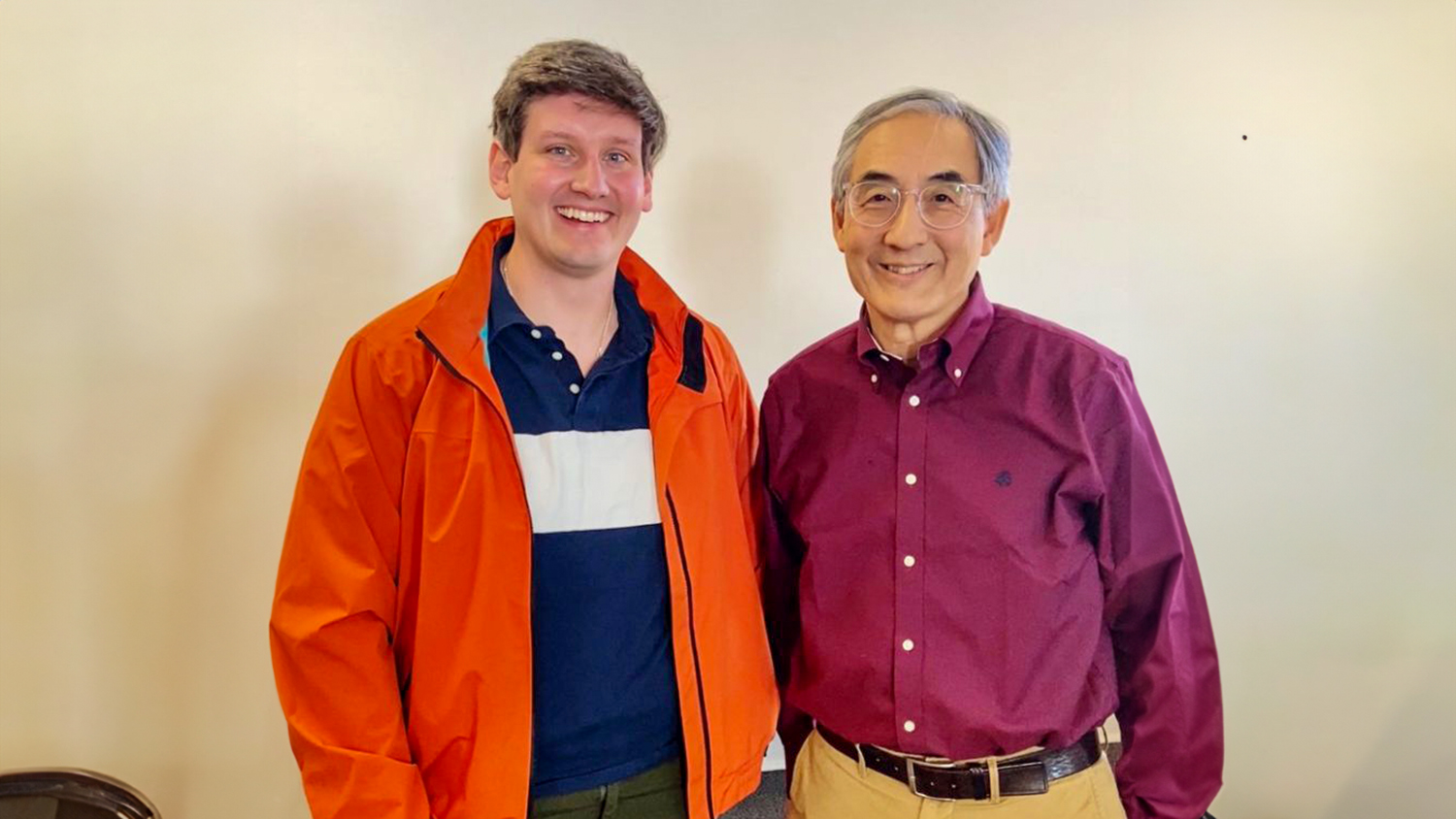
Written by: Nick Loschin
*Note: The opinions expressed in this article are those of the authors as individuals and should not be taken as a reflection of the views of the whole of the Genetic Engineering and Society Center or NC State University.
Dr. David Andow provided his insights and expertise on ecological and evolutionary perspectives related to genetic engineering through key events from the 1980s to the early 2000s

Nick Loschin with David Andow at the GES colloquium on February 6, 2024. Photo credit: Patti Mulligan
During the weekly GES Colloquium on February 6th (video, podcast), attendees were privileged to gain insights from Dr. David Andow, the newly appointed Department Head of Applied Ecology, as he navigated the historical trajectory of oversight for genetically engineered organisms through an ecological and evolutionary lens.
Who is Dr. Andow?
Dr. David Andow stands as a prominent figure in the field of ecology, specializing in insect population and community ecology, ecological risk assessment for invasive species, genetically engineered organisms, and science policy. Holding a Bachelor of Science in biology and a Ph.D. in ecology, Dr. Andow further honed his expertise through a postdoctoral research stint in Japan, where he delved into the intricacies of rice insects at the National Institute for Agro-Environmental Sciences in Tsukuba.
Notably, much of his academic career flourished at the Department of Entomology at the University of Minnesota-Twin Cities, where he served as a distinguished professor in the College of Food, Agricultural, and Natural Resource Sciences.
Dr. Andow’s influence extends globally through collaborations with institutions such as the Brazilian Agricultural Research Corporation and as a fellow at the Bellagio Center of the Rockefeller Foundation in Italy. This was furthered by his work with the World Trade Organization and as the chair of a U.S. Fish and Wildlife Services recovery team for the endangered Karner blue butterfly.
A Brief History of Genes
Dr. Andow interwove his international and professional experiences to construct a narrative encapsulating key events from the 1980s, 1990s, and early 2000s in the oversight of genetically modified organisms (GMOs).
1980s: Regulation of GMOs
He opened the conversation with a retrospective glance at the 1980s, a period following the Alisomar Conference of 1975, which heralded the inception of GMO regulation, primarily focusing on microbial organisms but later setting the stage for genetically modified plants.
Noteworthy was the U.S. EPA’s report on the environmental implications of GMOs, setting the stage for discussions revolving around five generic safety arguments posited by researchers and developers. These arguments centered around perceived similarities of GMOs to domesticated species, constraints on GMO expansion imposed by environmental factors, the potential limitations of disrupting optimized genomes, the idea that novelties would be a major burden and that evolution has already tried it all. Dr. Andow also underscored stakeholder apprehensions regarding the efficacy of genetic engineering and its commercial viability.
The decade culminated in the formulation of The Coordinated Framework for the Regulation of Biotechnology in 1986, heralding a collaborative oversight approach shared by the U.S. EPA, FDA, and USDA, tailored to a case-by-case approach to regulation.
1990s: Commercialization of GMOs
As regulation took foot, and developers continued to advance techniques in biotechnology, the 1990s became the decade of going to market for GMOs primarily in the U.S. with modifications in single locus traits. Headed by the Flavr Savr Tomato and genetically modified maize to open the door to the seed market, GMOs started to become more common.
In terms of regulation, there was a flood of applications to release GMOs but not nearly enough staff among the 3 agencies for a case-by-case approach. A notification system was used by the USDA, as well as an experimental use permit used by the EPA. Conversations began to happen over what it means to be a case, and loopholes were found by developers related to the intention of use, allowing products intended to be used for pharmaceuticals to avoid regulation altogether.
Risk assessments in this boom in commercialization were based on conventional models. For environmental considerations, this meant investigating nontarget effects, conventional ecological impacts, gene spread, and resistance evolution.
2000s: Consolidation and Revisions to Risk Assessment
The early 2000s marked a period of introspection and recalibration in response to burgeoning stakeholder concerns and ecological revelations, epitomized by the monarch butterfly study. This study highlighted the potential risks posed by Bt pollen to monarch butterfly populations, leading to further investigations to be conducted by the National Academy of Sciences and the three federal agencies. This pivotal moment expanded the discourse to encompass broader environmental parameters, including gene flow, and underscored the need for robust risk assessment protocols.
While Dr. Andow centered his talk around the U.S., he used these concerns to discuss pushback from other countries, such as Mexico. With concerns over environmental risks like gene flow, Mexico does not allow genetically engineered maize to be grown. However, this does not necessarily stop the illegal import of genetically modified seeds making their way over from the U.S.
Sparking Conversation
Dr. Andow covered these three decades using his own experiences, such as being part of the NAS report on the Environmental effects of transgenic plants, along with various consensus reports and national and international policy considerations on the topic.
The presentation touched on much of the work and interests of those affiliated with the GES Center, with questions and conversations going beyond the ecological considerations of GMOs. Discussions were focused on public perception of GMOs during the various decades and what impact this may have had on the decisions of seed companies to consolidate. Along with this was again asking questions about the benefits of the new traits developers are putting on the market and about the social and economic considerations when dealing with technology like terminator seeds.
Furthermore, there was a discussion on the monarch butterfly study and how it broadened the species considered in nontarget studies. When asked about what parameters may still need to be considered in the current regulation of GMOs, Dr. Andow responded by emphasizing the importance of looking at species that are culturally significant and what this may mean. He also cited the need for more understanding of the risks around gene flow and how novel genetic techniques such as CRISPR could lead to an increase in the risk of being outside the scope of regulation.
In under an hour, Dr. Andow covered the robustness of these decades of GMO regulation, succinctly by offering his insight into the various ecological implications of genetic engineering in the United States. Attendees of the presentation voiced the need for Dr. Andow to return and give a similar talk with a focus on his international research, namely in Mexico and Brazil.
Related: David Andow – Ecological and evolutionary perspectives on genetic engineering | GES Colloquium, 2/6/2024Nick Loschin is a PhD student in the AgBioFEWS program led by the GES Center at NC State, under the supervision of Dr. Khara Grieger. Nick is studying parameters and processes involved in conducting environmental risk assessment of genetically engineered crops.